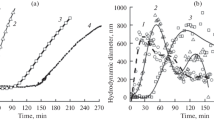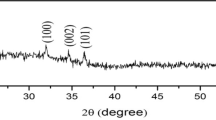Abstract
Novel glass electrodes for the determination of cations with reversible internal solid contact are introduced. They are based on a semiconducting zinc oxide layer with a maximum thickness of 1 µm in contact with ion selective glasses on one side and with a metal layer on the other side. The metal oxide layer is thereby generated either by ultrasonic spray pyrolysis from zinc acetate solution, by electrochemical deposition from zinc nitrate solution or by spin coating from a dispersion of ZnO in an organic binder. A following activation in a palladium chloride solution allows the chemical reductive deposition of NiP as electronic conductor. Dipping-type and flow through electrodes as well as planar glass electrodes in thick film technology fabricated in the above-mentioned method are described. In this case gold electrodes are applied by screen printing on isolated steel substrates. The zinc oxide layers, created in different manners, are covered afterwards with cation selective glasses in thick film technology. They cause a stabilisation of the half-cell potentials of the all solid state indicator electrodes proved by suitable measurements.













Similar content being viewed by others
References
Eisenman G (1967) Glass electrodes for hydrogen and other cations. Marcel Dekker, New York
Thompson MR (1932) Bur Stand J Res 9:833
Loiseleur J (1942) Ann Inst Pasteur 68:373
Krjukov PA, Krjukov AA (1937) Zavod Lab 6:619
Lengyel B. v (1931) Z Phys Chem 153:425
Voigtländer G (1963) Versuche zur Herstellung stabiler Glaselektroden. Diploma Thesis, Technische Hochschule Dresden
Wolf K (1927) Collegium 688:370
Emmerich B (1978) Regelungstech Prax 20:313
Belford RE, Owen AW, Kelly RG (1987) Sens Actuators 11:387
Kaden H, Vonau W (1990) Messen-Steuern-Regeln 33:312
Sultz MM, Pisarevskii AM, Volkov AM, Lepnev CE, Artmev CP, Nikolajev JM (1981) Physika i Chimia 7:426
Vonau W, Kaden H (1997) Glastech Ber (Glass Sci Technol) 70:155
Metz A (1970) US Patent 3:498–901
Noll A, Rudolf V, Grabner EW (1998) Electrochim Acta 44:415
Vonau W, Gabel J, Jahn H (2005) Electrochim Acta 50:4981
Jahn H, Kaden H (2004) Microchim Acta 146:173
Vonau W, Guth U (2006) J Solid State Electrochem 10:746
Yoshiki H, Alexandruk V, Hashimoto K, Fujishima A (1994) J Electrochem Soc 141:L56
Sun RD, Tryk DA, Hashimoto K, Fujishima A (1998) J Electrochem Soc 145:3378
Reinecke M, Spindler J, Berthold F, Vonau W (2002) Metalloberfläche 56:20
Beyer W, Hüpkes J, Stiebig H (2007) Thin Solid Films 516:147
Shinde VR, Gujar TP, Lokhande CD (2007) Sens Actuators B 120:551
Soki T, Hatanaka Y, Look DC (2000) Appl Phys Lett 76:3257
Caporaletti O (1982) Sol Eng Mater 7:65
Chernets AN, Kenigsberg NL (1973) Thin Solid Films 18:247
Nunes P, Fernandes B, Fortunato E, Vilarinho P, Martins R (1999) Thin Solid Films 337:176
Miki-Yoshida M, Collins-Martinez V, Amézaga-Madrid P, Aguilar-Elguézabal A (2002) Thin Solid Films 419:60
Ashour A, Kaid MA, El-Sayed NZ, Ibrahim AA (2006) Applied Surface Science 252:7844
Izaki M, Omi T (1996) Appl Phys Lett 68:2439
Gao F, Naik SP, Sasaki Y, Okubo T (2006) Thin Solid Films 495:68
NORM DIN 19262 11.1986 Steckbuchse und Stecker geschirmt für pH-Elektroden
Vonau W, Enseleit U, Kretzschmar C, Otschik P, Große M, Woithe W (2000) Mittweida Scientific Reports. J Univ Appl Sci Mittweida, Bd. I: Moderne Verfahren der Oberflächentechnik 13:25
NORM DIN 58196 07.1995 Dünne Schichten für die Optik - Teil 6: Prüfung der Haftfestigkeit mit einem Klebeband
Schmidt-Mende L, MacManus-Driscoll JL (2007) Materials Today 10/5:40
Acknowledgements
The present work was supported by the ‘Arbeitsgemeinschaft industrieller Forschungsvereinigungen’ (AiF 14555 BR) with funds of the Federal Ministry of Economics and Technology (BMWi). First donee: Deutsche Gesellschaft für Galvano- und Oberflächentechnik (DGO)
Author information
Authors and Affiliations
Corresponding author
Rights and permissions
About this article
Cite this article
Vonau, W., Gerlach, F., Enseleit, U. et al. New solid-state glass electrodes by using zinc oxide thin films as interface layer. J Solid State Electrochem 13, 91–98 (2009). https://doi.org/10.1007/s10008-008-0573-8
Received:
Revised:
Accepted:
Published:
Issue Date:
DOI: https://doi.org/10.1007/s10008-008-0573-8




